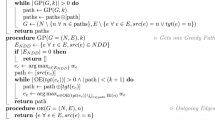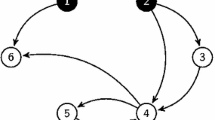Abstract
Kidney transplantation is vital for treating end-stage renal disease, impacting roughly one in a thousand Europeans. The search for a suitable deceased donor often leads to prolonged and uncertain wait times, making living donor transplants a viable alternative. However, approximately 40% of living donors are incompatible with their intended recipients. Therefore, many countries have established kidney exchange programs, allowing patients with incompatible donors to participate in “swap” arrangements, exchanging donors with other patients in similar situations. Several variants of the vertex-disjoint cycle cover problem model the above problem, which deals with different aspects of kidney exchange as required. This paper discusses several specific vertex-disjoint cycle cover variants and deals with finding the exact solution. We employ the dataless neural networks framework to establish single differentiable functions for each variant. Recent research highlights the framework’s effectiveness in representing several combinatorial optimization problems. Inspired by these findings, we propose customized dataless neural networks for vertex-disjoint cycle cover variants. We derive a differentiable function for each variant and prove that the function will attain its minimum value if an exact solution is found for the corresponding problem variant. We also provide proof of the correctness of our approach.






Similar content being viewed by others
Explore related subjects
Discover the latest articles, news and stories from top researchers in related subjects.Data availability
We have no data associated with this research.
References
Abraham DJ, Blum A, Sandholm T (2007) Clearing algorithms for barter exchange markets: Enabling nationwide kidney exchanges. In: Proceedings of the 8th ACM conference on Electronic commerce, pp 295–304
Akiba T, Iwata Y (2016) Branch-and-reduce exponential/FPT algorithms in practice: a case study of vertex cover. Theoret Comput Sci 609:211–225
Alkhouri Ismail R, Atia George K, Alvaro V (2022) A differentiable approach to the maximum independent set problem using dataless neural networks. Neural Netw 155:168–176
Ashlagi I, Fischer F, Kash IA, Procaccia AD (2015) Mix and match: a strategyproof mechanism for multi-hospital kidney exchange. Games Econom Behav 91:284–296
Ashlagi I, Gamarnik D, Rees MA, Roth AE (2012) The need for (long) chains in kidney exchange. Technical report, National Bureau of Economic Research
Ashlagi I, Roth AE (2014) Free riding and participation in large scale, multi-hospital kidney exchange. Theor Econ 9(3):817–863
Giorgio A, Pierluigi C, Giorgio G, Viggo K, Alberto M-S, Marco P (2012) Complexity and approximation: combinatorial optimization problems and their approximability properties. Springer, Cham
Bengio Y, Lodi A, Prouvost A (2021) Machine learning for combinatorial optimization: a methodological tour d’horizon. Eur J Oper Res 290(2):405–421
Blum A (2013) Algorithms: recitation notes. https://www.cs.cmu.edu/avrim/451f13/recitation/rec1016.txt
Boppana R, Halldórsson MM (1992) Approximating maximum independent sets by excluding subgraphs. BIT Numer Math 32(2):180–196
Jena SK, Subramani K, Velasquez A (2023) Differentiable discrete optimization using dataless neural networks. In: Weili W, Jianxiong G, (eds.), Combinatorial Optimization and Applications - 17th International Conference, COCOA 2023, Hawaii, HI, USA, December 15-17, 2023, Proceedings, Part II, vol 14462 of Lecture Notes in Computer Science, pp 3–15. Springer
Cornuejols G, Pulleyblank W (1980) A matching problem with side conditions. Discret Math 29(2):135–159
Cygan M, Fomin FV, Kowalik L, Lokshtanov D (2015) Dániel Marx. In: Michal P, Saket S (eds) Parameterized algorithms. Springer, Cham
Dickerson JP, Manlove DF, Plaut B, Sandholm T, Trimble J (2016) Position-indexed formulations for kidney exchange. In: Proceedings of the 2016 ACM Conference on Economics and Computation, pp 25–42
Ding Y, Ge D, He S, Ryan CT (2015) A non-asymptotic approach to analyzing kidney exchange graphs. In: Proceedings of the Sixteenth ACM Conference on Economics and Computation, pp 257–258
Drori I, Kharkar A, Sickinger WR, Kates B, Ma Q, Ge S, Dolev E, Dietrich B, Williamson DP, Udell M (2020) Learning to solve combinatorial optimization problems on real-world graphs in linear time. In: 2020 19th IEEE International Conference on Machine Learning and Applications (ICMLA), pp 19–24
Festa P (2014) A brief introduction to exact, approximation, and heuristic algorithms for solving hard combinatorial optimization problems. In 2014 16th International Conference on Transparent Optical Networks (ICTON), pp 1–20
Flum Jörg GM (2006) Parameterized complexity theory. Texts in theoretical computer science. An EATCS series. Springer, Cham
Fomin FV, Kratsch D (2010) Exact exponential algorithms. Texts in theoretical computer science. An EATCS series. Springer, Cham
Garey MR, Johnson DS (1991) Computers and intractability: a guide to the theory of np-completeness. W. H. Freeman Company, San Francisco
Gaspers S (2010) Exponential time algorithms-structures, measures, and bounds. VDM
Hartvigsen D (1984) Extensions of matching theory. PhD thesis, Carnegie Mellon University
Hartvigsen D (1999) The square-free 2-factor problem in bipartite graphs. In: International Conference on Integer Programming and Combinatorial Optimization, pp 234–241. Springer
Jena SK, Subramani K, Velasquez A (2024) A differential approach for several NP-hard optimization problems. In: International Workshop on Combinatorial Image Analysis, pp 68–80. Springer
Lamm S, Sanders P, Schulz C, Strash D, Werneck RF (2016) Finding near-optimal independent sets at scale. In: 2016 Proceedings of the Eighteenth Workshop on Algorithm Engineering and Experiments (ALENEX), pp 138–150
Li Z, Chen Q, Koltun V (2018) Combinatorial optimization with graph convolutional networks and guided tree search. In: Advances in neural information processing systems, p 31
Mazyavkina N, Sviridov S, Ivanov S, Burnaev E (2021) Reinforcement learning for combinatorial optimization: A survey. Comput Oper Res 134:105400
Niedermeier R (2006) Invitation to fixed-parameter algorithms. Oxford University Press, Oxford
Roth AE, Sönmez T, Ünver MU (2004) Kidney exchange. Quart J Econ 119(2):457–488
Roth AE, Tayfun S, Utku ÜM (2005) Pairwise kidney exchange. J Econ Theor 125(2):151–188
Roth AE, Sönmez T, Utku Ünver M (2007) Efficient kidney exchange: coincidence of wants in markets with compatibility-based preferences. Am Econ Rev 97(3):828–851
Segundo PS, Rodríguez-Losada D, Jiménez A (2011) An exact bit-parallel algorithm for the maximum clique problem. Comput Oper Res 38(2):571–581
Schuetz Martin JA, Kyle Brubaker J, Katzgraber Helmut G (2022) Combinatorial optimization with physics-inspired graph neural networks. Nat Mach Intell 4(4):367–377
Toulis P, Parkes DC (2015) Design and analysis of multi-hospital kidney exchange mechanisms using random graphs. Games Econom Behav 91:360–382
William TT (1954) A short proof of the factor theorem for finite graphs. Can J Math 6:347–352
Wilder B, Dilkina B, Tambe M (2019) Melding the data-decisions pipeline: Decision-focused learning for combinatorial optimization. In: Proceedings of the AAAI Conference on Artificial Intelligence, vol 33, pp 1658–1665
Funding
This research was supported in part by the Defense Advanced Research Projects Agency through Grant HR001123S0001-FP-004.
Author information
Authors and Affiliations
Corresponding author
Ethics declarations
Conflict of interest
We declare that we have no Conflict of interest.
Additional information
Publisher's Note
Springer Nature remains neutral with regard to jurisdictional claims in published maps and institutional affiliations.
Rights and permissions
Springer Nature or its licensor (e.g. a society or other partner) holds exclusive rights to this article under a publishing agreement with the author(s) or other rightsholder(s); author self-archiving of the accepted manuscript version of this article is solely governed by the terms of such publishing agreement and applicable law.
About this article
Cite this article
Jena, S.K., Subramani, K. & Velasquez, A. Designing dataless neural networks for kidney exchange variants. Neural Comput & Applic 36, 22265–22275 (2024). https://doi.org/10.1007/s00521-024-10352-6
Received:
Accepted:
Published:
Issue Date:
DOI: https://doi.org/10.1007/s00521-024-10352-6




